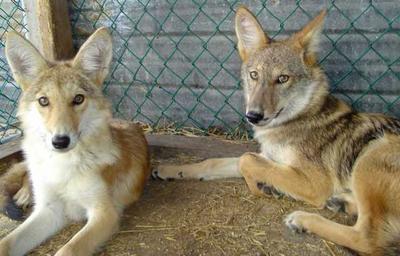Look at these two coyotes.
 Shelby and BrodyPhoto courtesy of the Kerwood Wolf Education Centre
Shelby and BrodyPhoto courtesy of the Kerwood Wolf Education Centre
This photograph came to me included with an appeal for donations to help build them a home at the Kerwood Wolf Education Centre. The story is that two different families who knew each other each turned in a coyote to a wildlife rehabilitation centre north of Kerwood (in southwestern Ontario) within a few days of each other, claiming that these were young of the year, and otherwise being sketchy about their origins. These are not young of the year, but young of last year. And they not only know each other very well, but are also very comfortable with human beings, walk well on leash, etc. So it is thought that they are litter mates that were taken from the wild last year as very young pups and raised in two households until they were no longer manageable. Coyotes (and wolves, cougars, tigers, etc.) do not make good pets. These animals are no longer good coyotes either--not candidates for rehabilitation. Obviously a coyote that is prone to running up to folks looking for a snack is not going to live very long in the farmlands of southwestern Ontario. So the Kerwood Centre is giving them a permanent home in captivity.
When I received the e-mail and saw the picture I was immediately struck by how different these two look from each other, and how much Brody, the animal on the right, looks like an eastern wolf. Look at the broad red nose and large nose pad. On the other hand, what big ears they both have. I wrote to Vivian of Kerwood to ask about them, and to ask if I could use the picture here, and she assured me that although "Brody does slightly (in some ways) resemble eastern wolves or even eastern wolf/coyote hybrids but the resemblance is actually very minor. He is definitely a coyote." And of course since she has hands-on experience with wolves and coyotes, and this one in particular, I am happy to take her word for this.
Really it is Shelby, the animal on the left, that is most remarkable--significantly different than any coyote or coyote image I've seen before--but different in ways that I can propose no explanation for. That is, she doesn't look at all "wolfish" nor does she look like a dog....so what is it about her? The most striking thing is all that white.
I regret that the history of these animals will probably never really be known, since they were taken illegally from the wild and the takers are unlikely to start talking about exactly where and how that occurred. Before I started my "watching brief" on the eastern coyote, the eastern wolf, the red wolf, etc. a few years ago, I had a "field-guide" view of the world. A species is a species--check the field marks of any critter, slot it into the right category. Not so with the wild dogs around here. Every coyote I've seen around here--and this has been a bonanza year for them (see
Signs of the Apocalypse and
Another County Encounter for example) has been markedly different from every other one. And every one I've seen in Ontario or Quebec has been so different from the delicate, long-legged one I saw in Alberta that one might think they were different species. Some, ones I've seen around Thomasburg, but probably not the ones I've seen in Prince Edward County, may well be eastern wolf/coyote hybrids. Even their DNA doesn't sort these creatures out very well.
Update--January 28, 2007I was alerted by a comment (see below) that there has been trouble at the Kerwood. Apparently animals were not being cared for properly, and a number, including a lion in very bad shape, were seized in November. I have no information about what has happened since, but the centre's website is mostly down.
Here are links to the stories in the London Free Press:
Wildlife Facility Raided and
Most animals thriving after rescue.
I am indebted to the commenter who alerted me to this. Very disturbing, and apparently something that developed after the centre attempted to expand its facilities to include exotic big cats. Sadly there are a lot of these animals in private hands in North America, and too many of them end up in very bad situations.
I really hope that nothing posted here ended up facilitating the ill-treatment of animals, native or exotic.


























